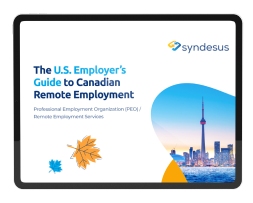In the face of layoffs at some of the biggest tech firms — with around 150,000 tech workers having been laid off in the past year — H-1B workers in the US have been hit particularly hard.
While layoffs are a part of life, especially at large companies, it’s never easy. Foreign-born tech workers on temporary work visas face immigration challenges during these situations.
In this article, we’ll look at how recent tech layoffs impact H-1B status in the US and how — despite similar layoffs of foreign nationals in Canada — a more fair and compassionate immigration system can have dramatically different impacts on individuals in similar circumstances.
There are major benefits to being in Canada during a layoff versus being in the US, as Canada’s immigration policies are much more fair and considerate of individuals on temporary work visas.
Let’s take a closer look at how layoffs abroad affect work visas differently, both north and south of the border.
Recent tech layoffs in North America
Although the tech industry has seen tremendous growth in recent decades, and continues to be a major driving force in the industry worldwide, the ongoing COVID-19 pandemic and resulting financial downturn has caused many firms to reduce costs wherever possible. Unprecedented market volatility and rising inflation have created uncertainty regarding profits, meaning companies have resorted to cutting jobs.
Tech businesses in particular have been making the tough decision to lay off staff due to the current economic climate. Most notably, major companies like Twitter let go of thousands of employees overnight, Meta reduced their workforce by over 13%, and Salesforce recently announced they’ll be cutting 10% of their workforce. These are by no means isolated incidents; the number of major layoffs continues to grow across many sectors leaving workers in limbo.
H-1B workers depend on their employers so they can remain in the US — when that employer reduces or eliminates their position, they become ineligible for a visa.
How have these layoffs impacted H-1B workers?
The staggering numbers of recent layoffs have severely impacted tech workers, particularly those who are employed on temporary visa programs, such as the H-1B.
Losing a job is always difficult, but it leaves immigrants in an incredibly precarious position. H-1B workers depend on their employers so they can remain in the US — when that employer reduces or eliminates their position, they become ineligible for a visa.
These visa holders are then required to leave the country if they can’t find a new job or change their visa status within sixty days, despite their desire to work and remain in the US. Many of these individuals have lived in the US for years, some even attended university in the country, and have families and lives — it’s unfair, to say the least.
In addition, finding a job within the tech industry right now is challenging and incredibly stressful. Over a third of the reported layoffs happened in the last month, meaning competition is at an all-time high. The talent exceeds the current job market leaving workers scrambling to find any available position.
By comparison, how do layoffs impact foreign-born tech workers in Canada?
Layoffs have also become a major reality for tech workers in Canada, with an increasing number of reports emerging about the ongoing impact on the industry.
Though the situation in Canada hasn’t been reported on as widely as in the US, the reality is that thousands of tech workers have been laid off from jobs in fields like software engineering, computer programming, and IT services as well.
However, layoffs in the US (particularly for those on H-1B visas) differ from layoffs in Canada for foreign-born tech workers on the Global Talent Stream (GTS).
Here are the key differences.
Canadian foreign workers have more time to find a new position
Tech workers in Canada on work permits, particularly those who have entered through the Global Talent Stream, don’t just have sixty days to find a new job but rather have the rest of the duration of their work permit.
Because they have more time to look for a new job and apply for a new work permit through a new employer, professionals are not left frantically looking for any kind of position available, whether it’s suitable or not.
The competition for positions is also less intense during mass layoffs because more time is available. It gives the individual time to consider their options; if they choose to stay in Canada, they may want to switch to a student visa or open a business by applying for an entrepreneur visa.
Serious life decisions don’t need to be made in haste.
There is a clear and quick pathway to permanent residency in Canada
For tech professionals thinking about Canada and considering what happens in a worst-case scenario, the truth is that they will be “exposed” for a much shorter period of time.
There is a level of security that’s difficult to find in the US with an H-1B visa. With the Global Talent Stream program for high-skilled technology workers, Canada has made it more manageable for foreign professionals to work and live in Canada long-term.
You can also live and work anywhere in Canada, you aren’t bound to one employer for a work permit, and you can apply for Canadian citizenship about four years later.
It is possible to apply for permanent residency after 12 months of full-time work in Canada. Once you have permanent residence status, you’re eligible to get most social benefits that Canadian citizens receive, including health care coverage.
You can also live and work anywhere in Canada, you aren’t bound to one employer for a work permit, and you can apply for Canadian citizenship about four years later.
In the unfortunate event that the individual is laid off, a Canadian permanent resident can stay in the country indefinitely, find other work and do whatever else is necessary to get back on their feet without worrying about their visa status.
Whether you are an H-1B worker who has been laid off recently or are still employed but considering your options given the risk of layoffs in the future, moving to Canada as a tech worker is possible!
Syndesus helps tech workers come to Canada!
For foreign-born tech workers currently based in the US who are either looking for new jobs or worrying about layoffs, Sydnesus offers two services to help.
Syndesus has turnkey PEO and EOR services that allow H-1B tech workers currently employed by a US-based company to hire you remotely in Canada, whether or not the company already has a legal entity in Canada.
This ideal scenario would allow you to continue working for your US-based employer while availing yourself of the benefits of Canada’s fair and favorable immigration policies, especially in the event of a future layoff.
On the other hand, if you’re an experienced tech worker in the US and you’ve lost your job, are worried about losing your job, or are otherwise interested in finding a new job for a Canadian tech employer, you can join our Path to Canada database as a qualified tech worker candidate and get matched with a Canadian tech employer.
Reach out to us to learn more!




